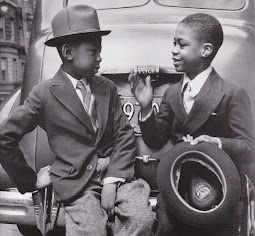The Harlem Renaissance began in 1918 and lasted until mid-1930’s. The roaring 20’s/Harlem Renaissance were in part a response to the immense loss of life that resulted from the Spanish Flu, also in 1918 - a pandemic that mirrors our experience of Covid in many ways. The black community, reeling from the horrors of slavery, but far enough away from themselves being slaves (and possibly the massive loss of life from the flu) were at a place to construct a new identity about what it meant to be a Black American. This is the foundation of the Harlem Renaissance - a search for a sense of their Identity within a space they never had the ability to shape on their own before. In the process of breaking down and rebuilding this national/cultural identity, Aaron Douglas - labeled the ‘father of Black American Art’ - was asked to do the important work of constructing a visual record of the shared history that united the black experience in America.
Part of the way Douglas’ work helped to establish a strong new sense of identity was by openly refuting aesthetic standards of the time (western european/traditional painting) and hearkening back to abstracted and deeply symbolic forms found in african and egyptian art - heritage that long preceded him and his contemporaries, but considered to be ‘savage’ and not afforded the regard that classical art forms had for the white western world. Blended with modernism and cubism, emerging art forms also disrupting the old school of art, Aaron Douglas refracted these different visual lenses to establish a language all his own - and in turn, a new branch formed in the history of art - an Identity for black americans to see themselves reflected in.
In Douglas’s famous mural series depicting the history of the Black American, each piece has some specific components that help tell the narrative - a sense of moving along a pathway, away from darkness/subjugation towards a beacon of hope/light, a clear sense of the past, the current state of making headway towards a distant symbolic future, and a figure we are following, as they lead others along that same path.
Together we are going to practice something similar, with cut paper as simpler forms, some with patterns and texture to inspire something that drawing cannot give us - and 4 things that must be included in your piece:
1. there must be a path
2. there must be something representing the past
3. there must be some kind of symbolic future
4. there must be someone (a version of yourself) guiding us away from the past, towards the future




















No comments:
Post a Comment